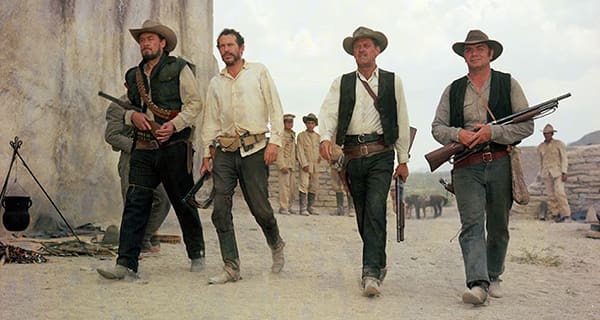 The big stories from the summer of 1969 were Neil Armstrong’s moon walk and the counterculture music extravaganza at Woodstock, N.Y. But there were also two classic westerns. One was True Grit and the other was The Wild Bunch.
The big stories from the summer of 1969 were Neil Armstrong’s moon walk and the counterculture music extravaganza at Woodstock, N.Y. But there were also two classic westerns. One was True Grit and the other was The Wild Bunch.
In fact, they debuted within a week of each other. True Grit opened on June 11 and The Wild Bunch followed on June 18.
True Grit – published in 1968 – was the second novel by Charles Portis. From the get-go, it attracted significant attention in Hollywood.
After reading the book, John Wayne decided he was going to play the male lead, the grizzled old marshal. Who produced the movie was immaterial. He was going to be Rooster Cogburn.
Portis, though, didn’t want Wayne. Nor did he care for the Marguerite Roberts script or the fact that location shooting was going to take place in picturesque Colorado rather than the book’s Arkansas habitat.
Business, however, was business. And having purchased the movie rights for a generous sum, producer Hal Wallis got to call the shots.
True Grit can be described as a story of intergenerational bonding, loyalty and righteous vengeance.
Set in the early post-Civil War period, it tells the tale of a young teenage girl who sets out to bring her father’s murderer to justice. To do so, she hires the crusty character played by Wayne, a man who firmly believes that “you can’t serve papers on a rat.” You get the drift.
The film was shot over three months between September and December 1968, going about 10 percent over budget in the process. That, however, didn’t much matter. It had hit written all over it.
Reviews were overwhelmingly positive and box office response was excellent. Yes, some critics dismissed Wayne’s performance on the grounds that it wasn’t much more than self-parody, although one wondered whether their disdain for his conservative politics coloured those assessments. In any event, he wound up with a Best Actor Oscar.
While True Grit wasn’t a typical western, it was still traditionally heroic. You couldn’t say the same for The Wild Bunch.
Directed by Sam Peckinpah, The Wild Bunch was immediately controversial for both its graphic violence and aura of nihilism. At the press conference following its screening for critics, a Reader’s Digest reporter wondered “Why was this film ever made?”
Technically, it was highly innovative thanks to the editing blend of multi-angle shots and the mixture of normal- and slow-motion images. But it was what those images portrayed that caused waves.
Indiscriminate violence, gratuitous cruelty and close-ups of blood spurting from gunshot wounds shocked significant numbers of people. Peckinpah had seen 1967’s Bonnie and Clyde and resolved that he, too, could do this. So he upped the mayhem and axed the one-liners. There were no romantic anti-heroes in The Wild Bunch.
Apparently, Peckinpah’s intent was to argue against the sanitization of western screen violence by underlining how the real thing is “ugly, brutalizing and bloody awful; it’s not fun and games and cowboys and Indians.”
Some commentators thought he’d achieved the opposite.
Film critic Pauline Kael put it this way:
“The movie, set in 1913, is about a band of killers who flee Texas for Mexico, and Peckinpah has very intricate, contradictory feelings about them. He got so wound up in the aesthetics of violence that what had begun as a realistic treatment – a deglamorization of warfare that would show how horribly gruesome killing really is – became instead an almost abstract fantasy about violence.”
The Wayne portrayal in True Grit is that of “a fat old man” with a stubborn streak and a propensity for solving problems with a gun. But he’s still admirable in a perverse way. Even lovable.
In the Wild Bunch, William Holden’s Pike Bishop is a different kettle of fish.
An erstwhile first-rank matinee idol, Oscar winner and private alcoholic, Holden shows his 50 years. And unlike Wayne’s Rooster Cogburn, there’s little to admire in the character he plays.
Still, it’s a strong performance. To quote Vincent Canby in the New York Times, “He looks older and tired, but he has style.”
Wayne didn’t much care for The Wild Bunch. It wasn’t because he feared the competition but rather that he felt it subverted something he treasured – the mythology of the Old West.
He was right.
Pat Murphy casts a history buff’s eye at the goings-on in our world. Never cynical – well, perhaps just a little bit.
© Troy Media
![]()
The views, opinions and positions expressed by columnists and contributors are the author’s alone. They do not inherently or expressly reflect the views, opinions and/or positions of our publication.


